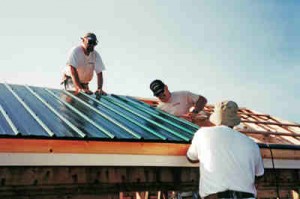Easy DIY Metal Roof Installation Tips
The rising number of people using metal roofs indicates the increasing popularity of this type of roofing. People who prefer metal roof do so for a variety of reasons, among which are durability (they are strong and fire-resistant), aesthetics appeal (available in different colors, shapes and designs) and energy-efficiency (reduction in power bills).
Metal roofing materials and designs are available for DIY metal roof enthusiasts. Doing it yourself means the finished project will be exactly according to your specifications and style plus you save money that would have been spent for contractor’s fees. If you are comfortable working with metals and not squeamish about heights, we have practical tips for you in installing metal roofs.
Tools Required
You can use standard hand tools to install metal roofs. These are hammer, screws, nails, tape measure, drill, chalk line, screw gun and metal snips. An electric metal shear is best for cutting panels, but a circular saw with abrasive blade can also do the job. For fastening metal plates together, both nails and screws will work just fine. Screws are, however, preferred by roofers because they offer superior resistance against pullout.
Prepare a Sketch and Measurement
Measure the areas to be covered by the roof. You will need precise measurements of the various parts (such as eaves lengths, chimneys, ridge length and valleys). Take several pictures of the roof from different positions and angles. This will aid you in preparing an accurate diagram, which in turn will help your local hardware facilitate the preparation of roofing materials.
Remove the Old Roof
We recommend removing the old roof before installing the new metal roofing for better foundation. Remove them when the weather is sunny since rains could ruin the materials inside the building. Start from the highest point on the roof.
Use Quality Underlayment
Use a high-quality underlayment before installing the metal material on the roof to guard against water infiltration and block out moisture between the metal and sheathing. A rubber underlayment at the eaves and beyond the exterior wall is advisable in cold climate to address water damage caused by ice damming.
Avoid Lead Pencils
Do not use standard lead or graphite pencils in marking panels because they speed up the rate of corrosion of the metal. Use a masking tape instead—it not only prevents corrosion but can be easily seen on the roof.
Professional Services
While you can probably complete the entire roof yourself, it is sometimes advisable to let professionals do certain parts to make sure they are done properly. These are the areas that require intricate workmanship that only experienced roofers could properly accomplish such as chimneys and skylights.
